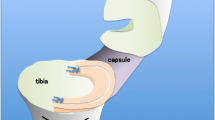Abstract
The contribution of the ligamentum teres to the stabilization of the hip joint and the clinical influence of a compromised ligamentum teres are not well known. This study aimed to investigate joint stability and cartilage damage in a rabbit model by surgically inducing a complete ligamentum teres tear. Twenty adult New Zealand rabbits were used in this study. Rabbits were divided into complete ligamentum teres tear with capsulotomy (n = 9, group I) and capsulotomy only (n = 10, group II) groups. Unilateral surgery was performed on the left hip. Joint instability was assessed by measuring the preoperative and postoperative acetabulofemoral (A-F) distances. Rabbits were euthanized to assess cartilage damage at 24 weeks postoperatively. The median postoperative A-F distance of the operated side in group I [0.68 cm (0.37–1.04 cm)] was larger than that in group II [0.50 cm (0.30–0.65 cm)] (p = 0.041). The median postoperative A-F distance was larger in the operated side [0.68 cm (0.37–1.04 cm)] compared to the nonoperated side [0.45 cm (0.30–0.75 cm)] in group I; it also was larger in the operated side [0.50 cm (0.30–0.65 cm)] compared to the nonoperated side [0.44 cm (0.32–0.67 cm)] in group II, but only group I showed a significant difference (p = 0.016 and 0.395, respectively). Articular cartilage damage was detected at the apex of the femoral head in two rabbits (22.2%) in group I only. Rabbits with a complete ligamentum teres tear showed significant instability at the hip joint and articular cartilage damage in our rabbit model, supporting the potential clinical importance of ligamentum teres as a hip joint stabilizer.





Similar content being viewed by others
References
Bardakos NV, Villar RN (2009) The ligamentum teres of the adult hip. J Bone Jt Surg 91:8–15
Botser IB, Martin DE, Stout CE, Domb BG (2011) Tears of the ligamentum teres: prevalence in hip arthroscopy using 2 classification systems. Am J Sports Med 39(Suppl):117S–125S
Byrd JW, Jones KS (2001) Hip arthroscopy in athletes. Clin Sports Med 20:749–761
Byrd JW, Jones KS (2004) Traumatic rupture of the ligamentum teres as a source of hip pain. Arthroscopy 20:385–391
Cerezal L, Kassarjian A, Canga A et al (2010) Anatomy, biomechanics, imaging, and management of ligamentum teres injuries. Radiographics 30:1637–1651
Church S, Keating JF (2005) Reconstruction of the anterior cruciate ligament: timing of surgery and the incidence of meniscal tears and degenerative change. J Bone Jt Surg 87:1639–1642
Hoemann C, Kandel R, Roberts S et al (2011) International Cartilage Repair Society (ICRS) recommended guidelines for histological endpoints for cartilage repair studies in animal models and clinical trials. Cartilage 2:153–172
Ilizaliturri VM Jr., Byrd JW, Sampson TG et al (2008) A geographic zone method to describe intra-articular pathology in hip arthroscopy: cadaveric study and preliminary report. Arthroscopy 24:534–539
Kaya M, Suziki T, Minowa T, Yamashita T (2014) Ligamentum teres injury is associated with the articular damage pattern in patients with femoroacetabular impingement. Arthroscopy 30:1582–1587
Kivlan BR, Clemente FR, Martin RL, Martin HD (2013) Function of the ligamentum teres during multi-planar movement of the hip joint. Knee Surg Sports Traumatol Arthrosc 21:1664–1668
Leunig M, Beck M, Stauffer E, Hertel R, Ganz R (2000) Free nerve endings in the ligamentum capitis femoris. Acta Orthop Scand 71:452–454
Li G, Moses JM, Papannagari R, Pathare NP, Defrate LE, Gill TJ (2006) Anterior cruciate ligament deficiency alters the in vivo motion of the tibiofemoral cartilage contact points in both the anteroposterior and mediolateral directions. J Bone Jt Surg 88:1826–1834
Lindner D, Sharp KG, Trenga AP, Stone J, Stake CE, Domb BG (2013) Arthroscopic ligamentum teres reconstruction. Arthrosc Tech 2:e21–e25
Martin RL, Martin HD (2015) Function and clinical relevance of the ligamentum teres: a current concept. Curr Orthop Pract 26:425–428
Martin RL, Palmer I, Martin HD (2012) Ligamentum teres: a functional description and potential clinical relevance. Knee Surg Sports Traumatol Arthrosc 20:1209–1214
Martin HD, Hatem MA, Kivlan BR, Martin RL (2014) Function of the ligamentum teres in limiting hip rotation: a cadaveric study. Arthroscopy 30:1085–1091
Noyes FR, Mooar PA, Matthews DS, Butler DL (1983) The symptomatic anterior cruciate-deficient knee. Part I: the long-term functional disability in athletically active individuals. J Bone Jt Surg Am 65:154–162
Philippon MJ, Pennock A, Gaskill TR (2012) Arthroscopic reconstruction of the ligamentum teres: technique and early outcomes. J Bone Jt Surg 94:1494–1498
Simpson JM, Field RE, Villar RN (2011) Arthroscopic reconstruction of the ligamentum teres. Arthroscopy 27:436–441
Weise K, Rupf G, Weinelt J (1988) Lateral ligament injury of the anterior ankle joint in sports. Aktuelle Traumatol 18(Suppl 1):54–66
Wenger DR, Mubarak SJ, Henderson PC, Miyanji F (2008) Ligamentum teres maintenance and transfer as a stabilizer in open reduction for pediatric hip dislocation: surgical technique and early clinical results. J Child Orthop 2:177–185
Yamamoto Y, Usui I (2006) Arthroscopic surgery for degenerative rupture of the ligamentum teres femoris. Arthroscopy 22(689):e1–e3
Acknowledgements
The authors are thankful to the veterinary team of the Laboratory Animal Unit of the Faculty of Medicine, Kyung Hee University.
Author information
Authors and Affiliations
Corresponding author
Ethics declarations
Conflict of interest
The authors declare that they have no conflict of interest.
Rights and permissions
About this article
Cite this article
Baek, J.H., Chun, Y.S., Rhyu, K.H. et al. Effect of ligamentum teres tear on the development of joint instability and articular cartilage damage: an in vivo rabbit study. Anat Sci Int 93, 262–268 (2018). https://doi.org/10.1007/s12565-017-0406-x
Received:
Accepted:
Published:
Issue Date:
DOI: https://doi.org/10.1007/s12565-017-0406-x




